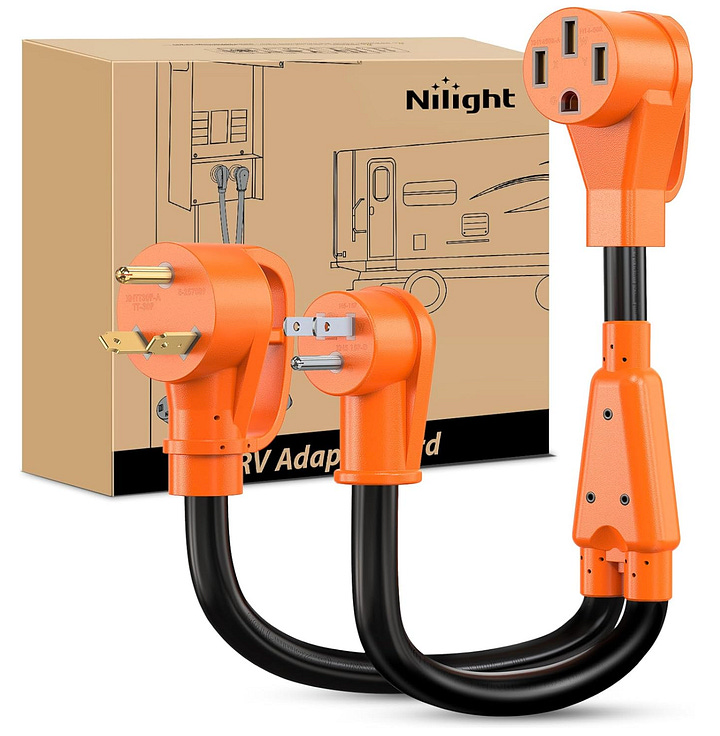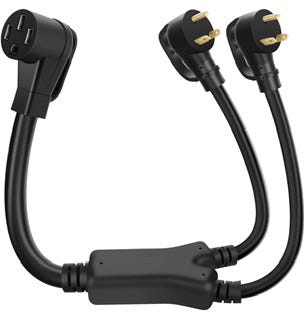Dual 30-amp to 50-amp Y-adapters
Are they safe and do they work? (Updated with Polarity Testing)
Dear Mike,
I have seen people using the 50 amp power cord on their coach to plug into a pair of 30-amp outlets. They plug their RV into a 50-amp Y-adapter which spits into two 30-amp male ends and then plug each end into a separate 30-amp outlet . They do this because there isn't a 50-amp outlet on the pedestal, but there are two separate 30-amp outlets. Is this safe to do for two weeks? -Tom
Hey Tom,
This is a possible solution as long as you understand the limitations.
Yes, this works if the pedestals are wired correctly
Note that this type of adapter has a pair of 30-amp male plugs feeding a single 50-amp female outlet. However, there’s two different ways the 30-amp outlets can be wired on the pedestal(s) than can affect operation.
If the two 30-amp outlets are wired on opposite Legs of the split-phase 120/240-volt service, (One on L1 and the other on L2), then the neutral currents in your shore power cord will be subtractive so the amperage will never exceed 30-amps. This is exactly how a properly wired 50-amp outlet is supposed to work, except you’ll only have a combined current of 60-amps available instead of the 100-amps in the standard 120/240-volt NEMA 14-50 pedestal outlet.
But if both of the 30-amp pedestal outlets are wired on the same split-phase Leg (L1+L1 or L2+L2), then the neutral currents will be additive, so it’s possible that the neutral conductor in your shore power cord would reach 60 amps. While technically a code violation since that neutral is only rated for 50 amps, unless you’re pulling 30-amps continuously from both sides of your RV power it should be safe. So if you do use one of these adapters you’ll want to keep a watch on any signs of overheating on the 50-amp shore power plug.
When it doesn’t work and makes fireworks
But, if one of the 30-amp receptacles is accidentally wired with Reverse Hot-Neutral Polarity, then plugging in a 30/30/50-Amp Y-Adapter will create a hot-to neutral short circuit. At the very least, you’ll trip circuit breakers. But you might create an arc-flash which can melt the contacts and possibly blind you if you’re not wearing eye protection.
See the video below which shows how to check for correct TT-30 Polarity before plugging in a 30/30/50-Amp Y-Adapter cable.
No, 45-amp Y adapters won’t work with a GFCI outlet
These so-called 45-amp Y-adapters that are designed to plug into one 30-amp and one 20-amp pedestal outlet just won’t work. That’s because all 20-amp outlets on pedestals are required to have GFCI protection. And because the neutral currents between the two outlets are intermingled, the GFCI 20-amp outlet will instantly trip with any load current over 5mA (that’s 0.005 amperes of load current). So don’t waste your money, because they can’t work with a GFCI outlet.


Just because you can buy something on Amazon of eBay doesn’t mean it’s safe or works.
Let’s play safe out there - Mike








Hi Mike,
I just discovered your blog and love it; can't stop reading. I have a concern about this 'Y' adapter though... If both ends are plugged in & connected to opposite phases of the split-phase 240VAC service, all should be good, I agree. What I'm concerned about is the (hopefully brief) time while only one of the line-side connectors is plugged in, if the load-side (RV side) connector is plugged in first. Do RVs with a 50A input have any 240VAC loads? If not... If everything is all 120VAC, then it wouldn't be a problem... but if there are any 240VAC loads, and if those loads are turned 'on', the 'hot' conductor on the plug that isn't yet plugged in becomes a source of low-impedance 120VAC from the OTHER phase until such time as it finally gets plugged in. If someone touches it, or it comes into contact with other metal before it's plugged in, it could cause a shock or short. In that respect it's similar to a suicide cable. To mitigate that risk you could recommend that the load-side (RV-side) connector always be the last to plug in & the first to unplug, but not everybody would always follow that recommended order.
How would you test for either of these situations to determine if it is safe?